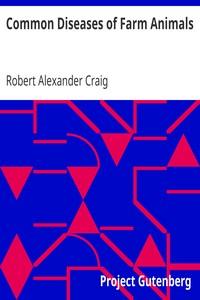Read this ebook for free! No credit card needed, absolutely nothing to pay.
Words: 90405 in 32 pages
This is an ebook sharing website. You can read the uploaded ebooks for free here. No credit cards needed, nothing to pay. If you want to own a digital copy of the ebook, or want to read offline with your favorite ebook-reader, then you can choose to buy and download the ebook.
REFERENCE BOOKS
GENERAL DISCUSSION OF DISEASE
Disease is the general term for any deviation from the normal or healthy condition of the body. The morbid processes that result in either slight or marked modifications of the normal condition are recognized by the injurious changes in the structure or function of the organ, or group of body organs involved. The increase in the secretion of urine noticeable in horses in the late fall and winter is caused by the cool weather and the decrease in the perspiration. If, however, the increase in the quantity of urine secreted occurs independently of any normal cause and is accompanied by an unthrifty and weakened condition of the animal, it would then characterize disease. Tissues may undergo changes in order to adapt themselves to different environments, or as a means of protecting themselves against injuries. The coat of a horse becomes heavy and appears rough if the animal is exposed to severe cold. A rough, staring coat is very common in horses affected by disease. The outer layer of the skin becomes thickened when subject to pressure or friction from the harness. This change in structure is purely protective and normal. In disease the deviation from normal must be more permanent in character than it is in the examples mentioned above, and in some way prove injurious to the body functions.
CAUSES.--For convenience we may divide the causes of disease into the predisposing or indirect, and the exciting or direct.
QUESTIONS
DIAGNOSIS AND SYMPTOMS OF DISEASE
The importance of recognizing or diagnosing the seat and nature of the morbid change occurring in an organ or group of organs cannot be overestimated. Laymen do not comprehend the difficulty or importance of correctly grouping the signs or symptoms of disease in such a way as to enable them to recognize the nature of the disease. In order to be able to understand the meaning of the many symptoms or signs of disease, we must possess knowledge of the structure and physiological functions of the different organs of the body. We must be familiar with the animal when it is in good health in order to be able to recognize any deviation from the normal due to disease, and we must learn from personal observation the different symptoms that characterize the different diseases. Stockmen should be able to tell when any of the animals in their care are sick as soon as the first symptom of disease manifests itself, by changes in the general appearance and behavior. But in order to ascertain the exact condition a general and systematic examination is necessary. The examiner, whether he be a layman or a veterinarian, must observe the animal carefully, noting the behavior, appearance, surroundings, and general and local symptoms.
Pulse.--The character of the intermittent expansion of the arteries, called the pulse, informs us as to the condition of the heart and blood-vessels. The frequency of the pulse beat varies in the different species of animals. The smaller the animal the more frequent the pulse. In young animals the number of beats per minute is greater than in adults. Excitement or fear, especially if the animal possesses a nervous temperament, increases the frequency of the pulse. During, and for a short time after, feeding and exercise, the pulse rate is higher than when the animal is standing at rest.
The following table gives the normal rate of the pulse beats per minute:
Horse 36 to 40 per minute Ox 45 to 50 per minute Sheep 70 to 80 per minute Pig 70 to 80 per minute Dog 90 to 100 per minute
RESPIRATION.--The frequency of the respirations varies with the species. The following table gives the frequency of the respirations in domestic animals:
Horse 8 to 10 per minute Ox 12 to 15 per minute Sheep 12 to 20 per minute Dog 15 to 20 per minute Pig 10 to 15 per minute
Free books android app tbrJar TBR JAR Read Free books online gutenberg
More posts by @FreeBooks

: Ice Creams Water Ices Frozen Puddings Together with Refreshments for all Social Affairs by Rorer S T - Cooking American; Ice cream ices etc.; Frozen desserts Cookbooks and Cooking


: Plays: Comrades; Facing Death; Pariah; Easter by Strindberg August Oland Edith Translator Oland Warner Translator - Drama; Strindberg August 1849-1912 Translations into English







